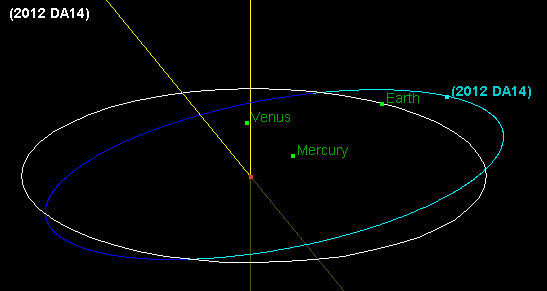(CelebNMusic247-News) 150-foot Asteroid to Skim Earth‘s Atmosphere
There is supposedly no reason to be afraid, but apparently a 150-foot wide asteroid will come remarkably close to Earth on Friday.
It will be the nearest known flyby for an object of this size and magnitude.
Here’s the drop via TOI:
But don’t worry. Scientists promise the mega rock will be at least 17,100 miles (27,518 kilometers) away when it zips on Friday (February 15th).
Donald Yeomans, manager of NASA’s Near-Earth Object program at Jet Propulsion Laboratory in Pasadena, California, said Thursday.
“No Earth impact is possible.”
Even the chance of an asteroid-satellite run-in is extremely remote, Yeomans and other scientists noted. A few hundred satellites orbit at 22,300 miles (35,886 kilometers), higher than the asteroid’s path, although operators are being warned about the incoming object for tracking purposes.
Yeomans told reporters:
“No one has raised a red flag, nor will they.”
“I certainly don’t anticipate any problems whatsoever.”
Impossible to see with the naked eye, the asteroid is considered small as these things go. By contrast, the one that took out the dinosaurs 65 million years ago was 6 miles (9.6 kilometers) wide.
Yet Asteroid 2012 DA14, as it’s known for its discovery date, still could pack a wallop.
If it impacted Earth – which it won’t, scientists were quick to add Thursday – it would release the energy equivalent of 2.4 million tons of TNT and wipe out 750 square miles (1,942 square kilometers). That’s what happened in Siberia in 1908, when forest land around the Tunguska River was flattened by a slightly smaller asteroid that exploded about five miles above ground.
The likelihood of something this size striking Earth is once in every 1,200 years. A close, harmless encounter like this is thought to occur every 40 years.
The bulk of the solar system’s asteroids are located between the orbits of Mars and Jupiter, and remain stable there for billions of years. Some occasionally pop out, though, into Earth’s neighborhood
The closest approach of this one will occur next Friday afternoon, Eastern time, over Indonesia.
There won’t be much of a show. The asteroid will zip by at 17,400 mph (28,000 kph). That’s roughly eight times faster than a bullet from a high-speed rifle.
The asteroid will be invisible to the naked eye and even with binoculars and telescopes will appear as a small point of light. The prime viewing locations will be in Asia, Australia and eastern Europe.
Observers in the U.S. can pretty much forget it. Astronomers using NASA’s deep-space antenna in California‘s Mojave Desert will have to wait eight hours after the closest approach to capture radar images.
Scientists welcome whatever pictures they get. The asteroid offers a unique opportunity to observe something this big and close, and any new knowledge will help if and when another killer asteroid is headed Earth’s way.
CelebNMusic247 brings you latest news on celebrity daily…Stay connect:
Stay Connected to CelebNMusic247.com: Follow us on Twitter – Like us onFacebook and Friend us on YouTube














